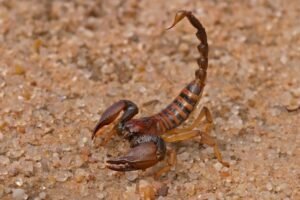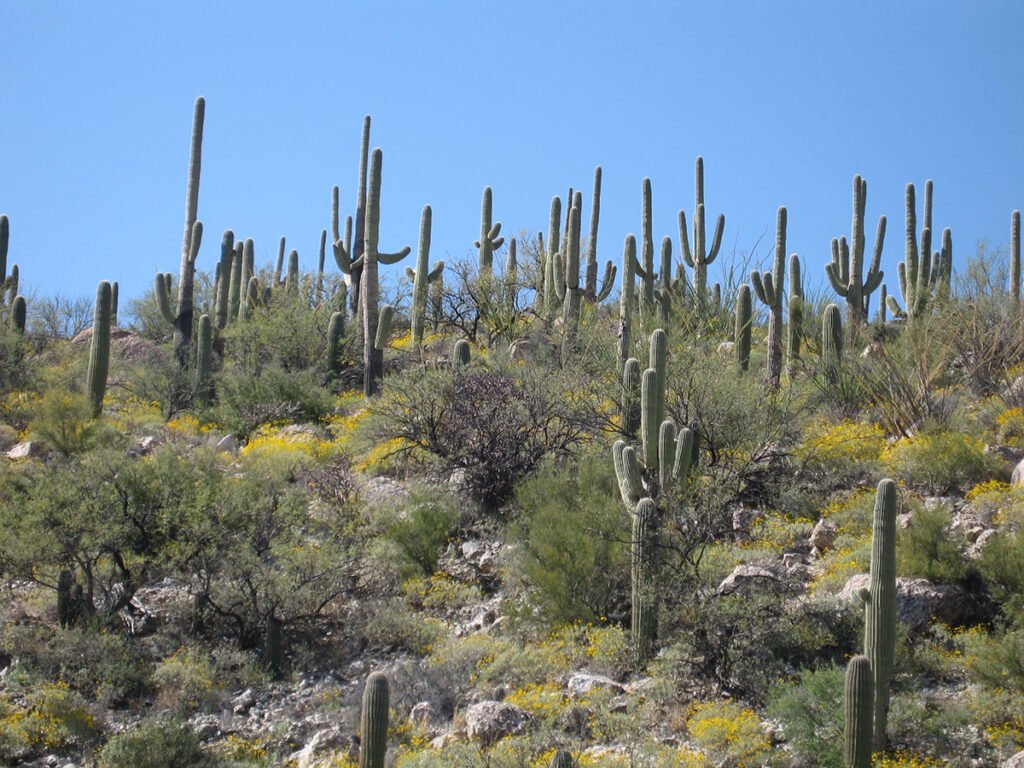A small article on the desert outside of Quartzsite
Geography and climate
According to the United States Census Bureau Quartzsite is all land and has a total area of 36.3 sq mi (94.0 km2).
Quartzsite lies on the western portion of the La Posa Plain along Tyson Wash. The Dome Rock Mountains overlook the town on the west with Granite Mountain on the southwest edge of the town and Oldman Mountain on the northwest. The Plomosa Mountains lie across the La Posa Plain to the east.
The town has a hot desert climate (Köppen BWh) with mild to warm winters from November to March and hot to extreme summers for the remainder of the year. In the middle of summer, Quartzsite is one of the hottest places in the United States and has recorded temperatures as high as 122 °F (50.0 °C) recorded on the 28th of July 1995.
There is very little precipitation with only 4.58 inches (116.3 mm) falling during an average year, while in May and June more than 80 percent of years do not have measurable rainfall. Since records began in 1928 the wettest month has been September 1939 with 6.16 inches (156.5 mm) which was part of the wettest year with 11.05 inches (280.7 mm) and featuring on September 5 the wettest day with 3.00 inches (76.2 mm). This moisture was due to the remnants of a rare Gulf of California hurricane.[11] The driest calendar year was 1928 with 0.92 inches (23.4 mm). However, between July 2001 and August 2002 as little as 0.45 inches (11.4 mm) fell over thirteen months.
Geological History of the Sonoran Desert
Tectonic Forces: The Sonoran Desert, a vast expanse of arid land spanning parts of California, Arizona, and northwestern Mexico, owes its existence to the powerful forces of plate tectonics. Over millions of years, the Earth’s crust has undergone gradual uplifting and stretching, sculpting the landscape into its current form.
Basin and Range Province: The region is a prominent part of the Basin and Range Province, a geological landscape characterized by a series of mountain ranges separated by elongated valleys. This distinctive pattern is the result of the Earth’s crust being pulled apart, creating alternating zones of uplift and subsidence.
Volcanic Activity: Volcanic forces have also played a significant role in shaping the Sonoran Desert. The region is dotted with volcanic cones and lava flows, remnants of past eruptions that have left their mark on the landscape.
Alluvial Fans: The desert’s topography is further characterized by alluvial fans, cone-shaped deposits of sediment carried by water from the surrounding mountains. These fans form as water flows down from higher elevations, gradually slowing and depositing its load of sediment.
Lakes and Erosion: In the distant past, the Sonoran Desert was not always as dry as it is today. Periods of increased precipitation led to the formation of ancient lakes, which left behind evidence of their existence in the form of sedimentary deposits. Over time, these lakes dried up, and erosion forces sculpted the landscape into its current arid state.

Major Plant and Animal Species:
The Sonoran Desert is rich in biodiversity, with numerous plant and animal species adapted to its harsh and arid conditions:
Plants of the Sonoran Desert
Saguaro Cactus: The quintessential symbol of the Sonoran Desert, the saguaro cactus can reach towering heights of 70 feet or more. These iconic plants have a deep taproot that allows them to access water deep in the soil. Their pleated stems expand to store water during the rainy season, enabling them to survive long periods of drought. Saguaros are slow-growing and can live for centuries.
Ocotillo: With its tall, spiny stems and bright red flowers, the ocotillo is a striking addition to the Sonoran Desert landscape. It’s a deciduous shrub that sheds its leaves during the dry season to conserve water. After a rain, the ocotillo quickly produces new leaves and flowers, adding a splash of color to the desert.
Joshua Tree: The Joshua tree is a distinctive yucca species that is found in the higher elevations of the Sonoran Desert. It has spiky leaves and clusters of white flowers. Joshua trees are slow-growing and can live for hundreds of years. They are an important source of food for many desert animals.
Palo Verde Trees: These “green stick” trees are well adapted to the desert environment. Their green bark contains chlorophyll, allowing them to photosynthesize and produce their own food. Palo verde trees are often the first trees to bloom in the spring, providing a source of nectar for pollinators.
Creosote Bush: The creosote bush is one of the most common plants in the Sonoran Desert. It is known for its distinctive aroma after a rain, which is caused by the release of volatile oils. Creosote bushes are highly adapted to drought and can live for thousands of years. They play an important role in stabilizing the desert soil and providing habitat for many desert animals.
Agave: Several species of agave, including the century plant, are found in the Sonoran Desert. These plants are known for their large, spiky leaves and their ability to store water. Agaves are a valuable source of food and fiber for humans and animals. They are also used to make tequila and mescal.
Animals of the Sonoran Desert
Gila Monster: The Gila monster is a venomous lizard and one of only two venomous lizards in North America. It is known for its striking black and orange coloration and its slow, deliberate movements. Gila monsters are primarily nocturnal and feed on small animals, such as rodents and birds.
Desert Tortoise: The desert tortoise is a threatened species that has adapted to the harsh conditions of the Sonoran Desert. It has a thick, domed shell that helps to protect it from predators and the elements. Desert tortoises are herbivores and feed on a variety of plants, including grasses, flowers, and cacti.
Sonoran Desert Toad: Known for its toxic secretions, which contain powerful hallucinogens, the Sonoran Desert toad is a large amphibian that is found in the desert and surrounding areas. It is primarily nocturnal and spends most of its time hiding in burrows or under rocks.
Coyote: The coyote is a highly adaptable predator that thrives in the Sonoran Desert. It is a carnivore and feeds on a variety of animals, including rodents, rabbits, birds, and reptiles. Coyotes are intelligent animals and are known for their ability to adapt to changing conditions.
Kangaroo Rat: Kangaroo rats are small, nocturnal rodents that are well adapted to desert life. They have long, powerful hind legs that allow them to hop quickly through the sand. Kangaroo rats are herbivores and feed on seeds and other plant matter. They are able to survive for long periods without drinking water by obtaining the moisture they need from their food.
Greater Roadrunner: The greater roadrunner is a fast-running bird that is known for its distinctive appearance. It has a long, slender body and a long tail. Roadrunners are carnivores and feed on a variety of animals, including insects, lizards, snakes, and small mammals.
Black-tailed Jackrabbit: The black-tailed jackrabbit is a desert hare that is one of the largest hares in North America. It has long ears and powerful hind legs that allow it to run quickly through the desert. Jackrabbits are herbivores and feed on grasses, shrubs, and other plants.
Cactus Wren: The cactus wren is the largest wren in North America. It is often found nesting in cacti, where it is protected from predators. Cactus wrens are omnivores and feed on insects, seeds, and berries. They are social birds and are often seen in pairs or small groups.
A word of caution
The Sonoran Desert, while beautiful, is home to several dangerous creatures. Among the most concerning are the venomous reptiles, such as the rattlesnake and gila monster. Their bites can cause severe pain and even be fatal if not treated promptly. Additionally, scorpions, with their painful stings, pose a threat to hikers and campers. Larger animals like mountain lions, while rare to encounter, can be dangerous if provoked. Lastly, insects like bees and wasps can inflict painful stings, especially if disturbed. To stay safe, it’s essential to wear appropriate footwear, be aware of your surroundings, and avoid disturbing wildlife.

The Sonoran Desert’s geologic history has played a crucial role in shaping its unique ecosystems and supporting a wide variety of plant and animal species specially adapted to its extreme conditions.

